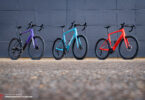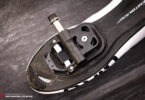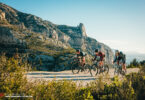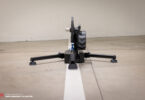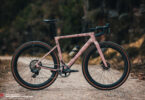DYED IN THE WOOL bikepacking bags long-term review
It doesn’t get any lighter. DYED IN THE WOOL ultralight bikepacking bags are the stuff that every bikepacker’s dreams are made of. Can the bags offer a good fit and the durability required for life on the road or does the ultra-light design also have its downsides? We put them to the test to find out.
Let us introduce you to Aleks and Charles? They’re two bike crazy people just like you and I. They started producing bikepacking bags for themselves but by the time they’d outfitted their entire circle of friends with pretty bags, the quality of which was hard to find its equal on the market, they decided to take the next step and earn their living by making bags! By specialising in the innovative Dyneema fabric and Dyneema printing technology, they’ve set themselves apart from the competition. The bags are all made to order, allowing you to choose the colour as well as the material. They’ll even make bags for cargo bikes! As you can see, there are no limits to your imagination with DITW. But how do the bags perform in practice? We had a complete set made for the Mason Bokeh gravel bike and tested it extensively on several bikepacking tours.
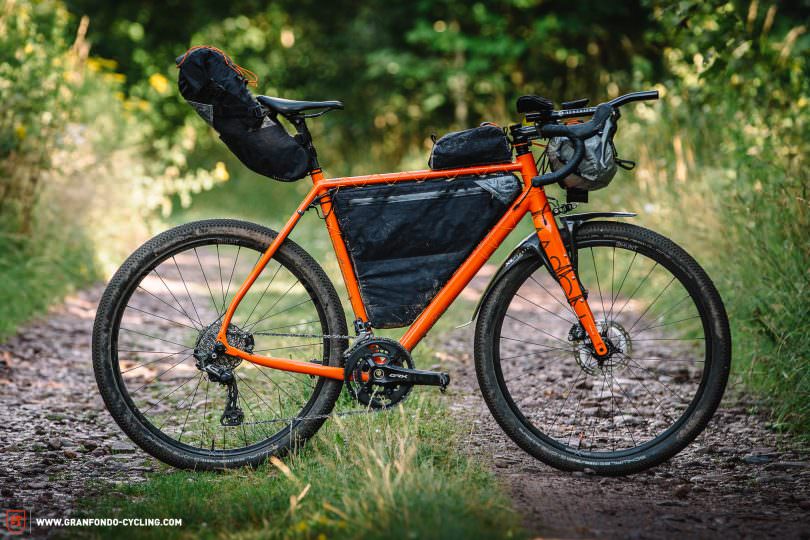
The HARNESS AND DRY BAG set
The harness gets mounted to the bars and weighs just 234 g, including the dry bag. The setup costs € 180. Despite its low weight, the harness is very stable and attaches to the handlebar via two straps, where it remains securely in place even when the going gets rough. The two rubber straps on the top give you quick and easy access to a windproof or other items of clothing while riding. Due to its compact design and construction, there’s enough space remaining to mount a headlight. However, you’re likely to require an alternative mount for your GPS when the harness is attached to the handlebar. For example, we couldn’t use the standard Wahoo bracket for the Wahoo ELEMNT ROAM, so our test rider Ben resorted to the Tune Porteur stem mount instead. The Dyneema bag used with the harness weighs just 65 g for the 4.5 l version and can be accessed from both sides. This gives you enough space for a compact sleeping bag, mat and a lightweight footprint for your tent. Rain and moisture can’t penetrate the bag and its contents remain dry at all times. The Dyneema fabric is very resistant to tearing but isn’t particularly resistant to abrasion, easily getting punctured when coming into contact with rocks or sharp objects or if it gets pinched in the fasteners. Overall, the set is very easy to use. When you arrive at camp, the bag can be removed with a flick of the hand, leaving the harness in place on the bike for the entire journey. Easy and foolproof!



The two-part construction of carrier and roll bag attached to it is relatively compact. Nevertheless, you should check before each ride whether there is enough space to the front wheel and the brake handles or whether you might need a different computer mount.
The TOP TUBE BAG
Next up is the TOP TUBE BAG, which weighs 88 g, has a storage capacity of 0.4 l and will set you back € 150. As with the other bags, DITW remain true to their preference for Dyneema and can make the TOP TUBE BAG using the ultralight fabric. The top tube bag gets strapped to the bike with a Dyneema cord around the top tube and an elasticated band around the steerer tube, which always kept it in place during the test, even when fully loaded. Attaching it is a bit fiddly, but it happily stays put once it’s on. The zipper is easy to use even while riding and the bag offers enough space for a power bank and snacks. For our tester, one thing is certain: he’ll never go on a bikepacking trip without the TOP TUBE BAG again!

After the somewhat fiddly assembly, the small top tube bag sits bombproof and takes good care of your most important essentials. The zip can also be easily operated with one hand.
The FRAME PACK
To achieve the perfect fit, the FRAME PACK gets made to measure in a process that couldn’t be easier. All you have to do is send the DITW team a photo of your bike with a tape measure along one of the frame tubes. The team then generates a scaled template which they send to you to print out on several A4 pages, letting you check the accuracy of the fit on your bike. This ensures that everything fits perfectly before the bag is manufactured, which on our bike has a storage volume of 5 l and weighs only 247 g. This set us back by a whopping € 300! It was worth it as the bag fits the bike like a glove and the Mason has been rocking its tailor-made suit every day since! You can also specify the locations of the bottle cage bosses on your frame so that they can be used to bolt the bag to the frame. We decided to fill the complete front triangle with the bag, attaching it to both bottle cage bosses and relocating the bottle cages to the fork. The bag gets attached to the top tube via a cord made of Dyneema – obviously ;). The advantage of this over regular straps is that the weight is distributed evenly across the bag’s full length. However, we recommend covering the top tube with protective tape or film before attaching the bag as the cords will quickly scuff the paint.

The large frame bag can be divided in the middle and thus has either one large or two smaller compartments. The zips are absolutely waterproof, but do get a little snaggy over time.
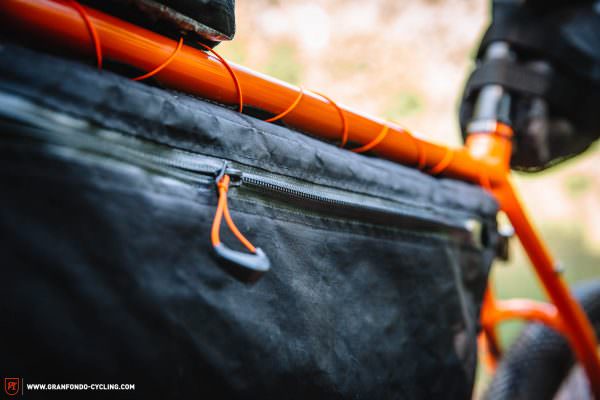
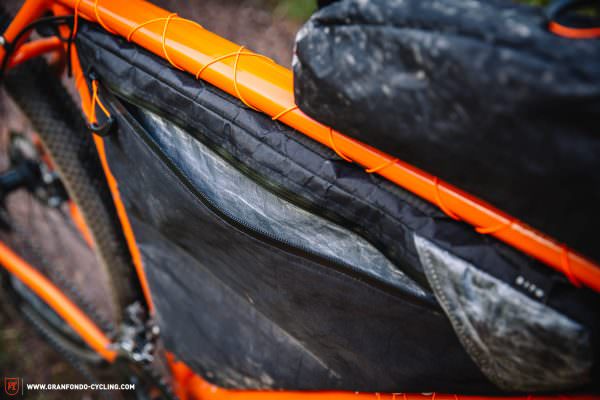
Dyneema is also used on the inside to complete the look, combined with waterproof Oxford fabric. For the upper material, you can choose between Cordura, X-Pac or Dyneema, depending on your preference. The delicate zippers are water-repellent but they do have a tendency to get stuck. It would have been better not to count every gram and resort to something more robust. Of course, zips are always going to be tricky with such perfectly fitting bags. When there is tension on the material, they inevitably become difficult to close. The inside is cleverly divided with a zipper, allowing you to choose between one large or two smaller compartments. In addition, the division adds lateral support and prevents the bag from bulging in the middle. In any case, it never rubbed our test rider’s legs, despite his impressively well-developed calves ;). Admittedly, attaching the bag is a bit fiddly and takes a lot of patience, just like the top tube bag. However, once fitted, it was bombproof and has stayed on the bike ever since. Finally, a word of warning. Be careful when riding in stormy weather, especially if it’s your first time, as the effect of cross winds gets amplified significantly with the bag!
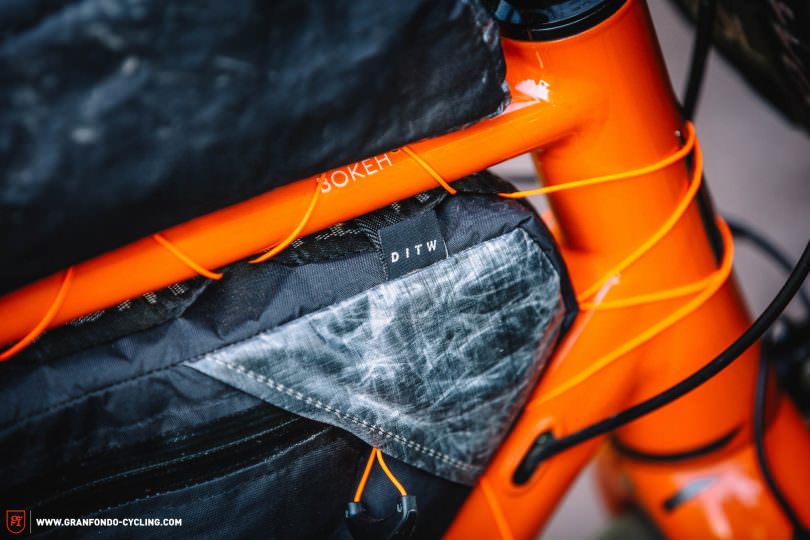
The Dyneema fabric of the bikepacking set shines with high tear resistance and because it is waterproof. It is only susceptible to mechanical impact: sharp objects or a stone on which the bike is carelessly placed can quickly cause a hole.
The SEAT PACK
Last but not least, the saddlebag, giving you a storage capacity of 6 l, weighing a scant 203 g and costing € 220. To make it fully weatherproof, DITW have resorted to double-stitched seams. It features a roll top closure and bungee cords on the top, which we unfortunately found to be a little too close to the opening. As such, unless the bag is filled to capacity, the bungee cords get partially rolled up. While the one-piece construction allows the weight to be kept ridiculously low, it also has a disadvantage. You don’t get the same convenience as you do with the two-part harness and bag solution up front. The external compartment on the underside of the saddlebag is very convenient. It offers the perfect place to store your tent poles, getting them out of the way while stabilising the bag. When it comes to the design, Aleks and Charles demonstrate the depth of their bikepacking know-how. Instead of sticking horizontally out to the back, the bag is more upright. As a result, it’s less susceptible to swaying from side to side as you pedal, which works brilliantly in real-world use! The only drawback is that if you stuff a lot of things under the bungee cords, such as a pair of flip flops, it can rub against your back. Just like the frame bag, the inside consists of a combination of Dyneema and waterproof Oxford fabric. For the upper material you can choose from Cordura, X-Pac or Dyneema depending on your preference or budget. In terms of fit, the SEAT PACK attaches to the bike just as securely as its counterparts on the cockpit and in the front triangle, attached firmly to the saddle and seat post. Unfortunately, the strap eventually started coming loose, tearing away from the bag. On the upside, Charles can fix anything!
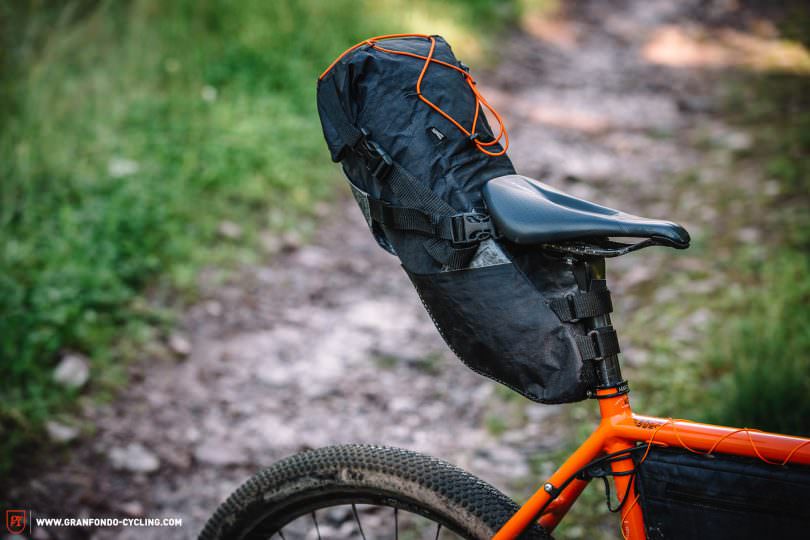
The saddle bag of the DYED IN THE WOOL bikepacking set goes up very steeply behind the saddle. This noticeably reduces side movements of the bag – however, luggage that is attached to the top of the bag can come into contact with the buttocks.

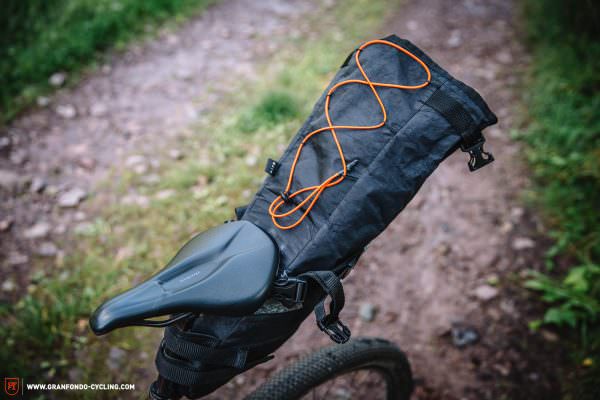
DYED IN THE WOOL bikepacking bags conclusion
If you’re looking for an ultralight bikepacking bag set, there’s no way around the bags from Aleks and Charles. All DITW bags are of extremely high quality and, despite their very low weight, remain stable and secure on the bike. Fortunately, you won’t be attaching the bags to your bike every day as doing so can be quite fiddly! The bags have become Ben’s loyal companions and now join him on most rides with the Mason.
Tops
- ridiculously lightweight
- beautiful workmanship
- secure fit without shifting out of place or losing their shape
- excellent features such as the zipper dividing the frame bag or the storage compartment on the underside of the saddlebag
- custom frame bag is a big advantage
Flops
- the saddlebag strap started coming off during the test
- the zips of the frame bag are too delicate
- Dyneema is very susceptible to abrasion from rocks or sharp objects
Tester Ben
Test duration 12 months
Price € 850 (complete set)
Weight 772 g (complete set)
Intended use bikepacking
For more information about the DITW bags visit dyedinthewool.eu

Did you enjoy this article? If so, we would be stoked if you decide to support us with a monthly contribution. By becoming a supporter of GRAN FONDO, you will help secure a sustainable future for high-quality cycling journalism. Click here to learn more.
Words: Philipp Schwab, Benjamin Topf Photos: Benjamin Topf

